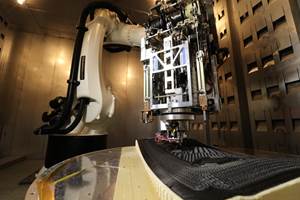Meltio Software Simplifies Wire-Laser Metal 3D Printing Technology
Meltio Space robot slicer employs a virtual model of the real robot movement.
Meltio created the Meltio Space toolpath generator to facilitate the use of its metal 3D printing solutions. By offering a user-friendly interface and comprehensive features, this robot slicer simplifies the integration of Meltio’s wire-laser metal 3D printing technology by offering a built-in robot library and postprocessors for some of the most popular robotic brands, including ABB, Kuka, FANUC and Yaskawa.
This toolpath generator software for the Meltio Engine Robot Integration offers an easy-to-use interface for planar, nonplanar, and variable extrusion toolpaths. It also includes 2-axis workpiece positioner interpolation, kinematics simulation, collisions check and cell configuration.
This slicer offers a new perspective on 3D printing by breaking free from the limitations of traditional 3-axis systems, and expands the possibilities by incorporating advanced robotic manipulation capabilities. Featuring an intuitive design, users can quickly adapt to and leverage the benefits of robotic additive manufacturing (AM) without requiring expertise in robotics or programming.
Also, Meltio Space goes beyond the constraints of traditional 3-axis systems. With its integration of a 6-axis robotic manipulator and 2-axis workpiece positioners, it opens up a new realm of possibilities for metal 3D printing. The comprehensive coordination, multi-axis toolpath generation, and enhanced design freedom provided by Meltio Space empowers users to create intricate, customized and highly detailed metal parts.
It is designed for using the Meltio Engine integrated into a robotic arm. Prior to launching Meltio Space, the company had agreements with 12 major software companies with which its technology is compatible and open. Now, the Meltio Space software facilitates the use or adoption of its wire-laser technology for industrial customers who do not have specific expertise in robotics and AM.
Meltio Space includes preset and recommended material profiles and 3D printing parameters. Moreover, Meltio Space removes complexity in the 3D printing workflow, making it accessible to industrial users of all levels. Whether it's understanding the interpolation of workpiece positioners or applying slicing strategies, Meltio Space streamlines the entire process, enabling users to embrace the power of AM with ease, offering a unified platform that enhances workflow efficiency and productivity.
With a strong focus on user experience, it offers a fully tailored customer journey centered around the seamless integration between the Meltio Engine and Meltio Space. The software offers custom-developed Meltio print profiles for the Meltio materials portfolio. With its intuitive design, users can quickly adapt to and leverage the benefits of robotic AM without requiring expertise in robotics or programming.
Meltio Space robot slicer employs a virtual model of the real robot movement. This advanced feature enables users to simulate the kinematics of the robot, ensuring accurate and precise printing. Additionally, the slicer performs collision checks with the part being printed, minimizing the risk of errors or damage during the additive manufacturing process.
- Learn more about Meltio’s wire-laser metal 3D printing technology for easier use, reliability. Its printing technology was developed to make the M450 metal 3D printer, Engine CNC Integration and Engine Robot Integration faster, more precise, easier to use and more reliable.
- Read about CNC Engineering’s collaboration with Meltio to design a solution that combines the power and reliability of FANUC CNC with cutting edge additive manufacturing technology.
Related Content
How 3D Printing Will Change Composites Manufacturing
A Q&A with the editor-in-chief of CompositesWorld explores tooling, continuous fiber, hybrid processes, and the opportunities for smaller and more intricate composite parts.
Read MoreAircraft Ducts 3D Printed in Composite Instead of Metal: The Cool Parts Show #68
Eaton’s new reinforced PEKK, tailored to aircraft applications, provides a cheaper and faster way to make ducts compared to formed aluminum.
Read More8 Cool Parts From RAPID+TCT 2022: The Cool Parts Show #46
AM parts for applications from automotive to aircraft to furniture, in materials including ceramic, foam, metal and copper-coated polymer.
Read MoreCan the U.S. Become Self-Sufficient in Aerospace Alloy Metal Powders?
6K’s technology can upcycle titanium and nickel-alloy parts into additive manufacturing powder. Here is how the circular economy helps national security.
Read MoreRead Next
Hybrid Additive Manufacturing Machine Tools Continue to Make Gains (Includes Video)
The hybrid machine tool is an idea that continues to advance. Two important developments of recent years expand the possibilities for this platform.
Read More4 Ways the Education and Training Challenge Is Different for Additive Manufacturing
The advance of additive manufacturing means we need more professionals educated in AM technology.
Read More3D Printing Brings Sustainability, Accessibility to Glass Manufacturing
Australian startup Maple Glass Printing has developed a process for extruding glass into artwork, lab implements and architectural elements. Along the way, the company has also found more efficient ways of recycling this material.
Read More























